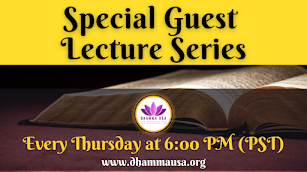The Art and Architecture of Buddhism: A Unique Cultural Contribution in Ancient India
By Nivitigala Sumitta Thero (Bhante Sumitta)
Abstract
Buddhism’s arrival in ancient India brought about a distinctive cultural transformation in the realms of art and architecture. As a new religious tradition, Buddhism introduced innovative artistic expressions and architectural forms that significantly influenced Indian culture and beyond. This article explores the unique contributions of Buddhism to art and architecture in ancient India, focusing on the development of stupas, monasteries, and Buddhist iconography, and examines how these contributions shaped both religious and secular artistic traditions.
Introduction
Buddhism, founded in the 6th century BCE by Siddhartha Gautama, introduced a distinctive approach to art and architecture that reflected its philosophical and spiritual values. The artistic and architectural developments under Buddhism in ancient India were not merely expressions of religious devotion but also significant cultural contributions that influenced subsequent artistic traditions across Asia. This article examines the unique contributions of Buddhism to art and architecture, highlighting the development of stupas, monasteries, and Buddhist iconography.
Development of Stupas
1. Symbolic Significance of Stupas
Stupas, the dome-shaped structures housing relics of the Buddha and other esteemed monks, are among the most iconic contributions of Buddhist architecture. According to A. L. Basham in The Wonder That Was India, stupas were designed to symbolize the Buddha's presence and his teachings, serving as focal points for meditation and worship.^1 The stupa's design, with its central dome and surrounding harmika, represents the cosmos and the Buddhist path to enlightenment. The architectural innovation of the stupa not only provided a space for religious practice but also became a model for subsequent Buddhist structures across Asia.
2. Evolution and Regional Variations
The evolution of stupas over time reflects the dynamic nature of Buddhist art and architecture. As detailed by M. K. Dhavalikar in The Buddhist Stupa and Its Origin, early stupas were simple and unadorned, but later developments included intricate carvings and elaborate gateways known as toranas.^2 These regional variations in stupa design illustrate the adaptation of Buddhist art to local cultural contexts while maintaining core symbolic elements.
Monastic Architecture
1. Viharas and Chaityas
The development of monastic complexes, including viharas (monasteries) and chaityas (prayer halls), was another significant contribution of Buddhism to architecture. Viharas provided living quarters for monks and spaces for study and meditation. In Indian Temple Architecture: Forms and Symbols, Michael W. Meister describes how viharas were designed to accommodate communal living and spiritual practice, with features such as cells for meditation and dining halls.^3 Chaityas, on the other hand, were prayer halls that often included rock-cut elements, as seen in the famous Ajanta and Ellora caves.
2. Rock-Cut Architecture
Buddhism’s contribution to rock-cut architecture is exemplified by the elaborate cave complexes found at Ajanta and Ellora. These sites, detailed in The Ajanta Caves: A Conservation Guide by John C. Huntington, showcase the integration of natural rock formations with intricate carvings and murals depicting the life of the Buddha and various Jataka tales.^4 The rock-cut temples and monasteries not only served religious purposes but also demonstrated advanced engineering and artistic skills.
Buddhist Iconography
1. Early Representations and Symbolism
Buddhist iconography, including the depiction of the Buddha and various Bodhisattvas, represents a crucial aspect of Buddhist art. As described by Susan L. Huntington in The Art of Ancient India: Buddhist, Hindu, Jain, early Buddhist art focused on symbolic representations of the Buddha, such as the lotus, the wheel of Dharma, and the empty throne, which conveyed his presence without direct representation.^5 This approach gradually evolved to include more direct representations of the Buddha and his followers, reflecting the development of Buddhist thought and practice.
2. Influence on Regional Art
The influence of Buddhist iconography extended beyond India, shaping the artistic traditions of East and Southeast Asia. In The Influence of Buddhism on Art in Asia, John C. Huntington explores how Buddhist art and iconography traveled with the spread of Buddhism, impacting artistic traditions in China, Japan, and Thailand.^6 This cross-cultural exchange demonstrates Buddhism’s significant role in shaping global artistic and architectural heritage.
Conclusion
Buddhism’s contributions to art and architecture in ancient India were profound and transformative. The development of stupas, monastic complexes, and distinctive Buddhist iconography not only enriched Indian artistic traditions but also had a lasting impact on the art and architecture of Asia. By introducing new forms and symbolic meanings, Buddhism played a crucial role in shaping cultural expressions and religious practices, leaving a legacy that continues to influence artistic and architectural traditions today.
References
1 A. L. Basham, The Wonder That Was India (New York: Grove Press, 1954). Link
2 M. K. Dhavalikar, The Buddhist Stupa and Its Origin (Mumbai: Indian Council of Historical Research, 1970). Link
3 Michael W. Meister, Indian Temple Architecture: Forms and Symbols (New Delhi: D. K. Printworld, 1996). Link
4 John C. Huntington, The Ajanta Caves: A Conservation Guide (New York: American Institute of Indian Studies, 1985). Link
5 Susan L. Huntington, The Art of Ancient India: Buddhist, Hindu, Jain (New York: Harry N. Abrams, 1985). Link
6 John C. Huntington, The Influence of Buddhism on Art in Asia (Cambridge: Cambridge University Press, 2003). Link































0 comments:
Post a Comment
Your comments and feedback are very helpful to us in improving our posts. We really appreciate your time. Thank you!
Dhamma USA Team.